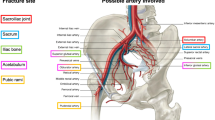Abstract
Purpose
The objectives of this study were to calculate the total volumetric rate of abdominopelvic bleeding in patients with acute pelvic fractures and examine the relationships between the bleeding rate, patient outcomes, and required patient interventions.
Methods
This was a retrospective cohort study which included 29 patients from a 4-year period (May 2013 to May 2017). Patients with acute pelvic fractures and active bleeding detected on CT with two phases of imaging were included. Software was used to measure the volume of active bleeding on arterial and parenchymal phases. The active bleeding rate was calculated by dividing the change in active bleeding volume by the time between the two phases. The total volumetric bleed rate from all sites was then computed. Clinical variables were compared between survivors and non-survivors.
Results
Overall mortality in this cohort was 21% (n = 6). The mean abdominopelvic volumetric bleed rate in non-survivors was much greater than survivors (40.7 cc/min vs. 5.7 cc/min; p < 0.01). Ninety-six percent of survivors had an abdominopelvic bleed rate < 20 cc/min compared to 33% of non-survivors. An abdominopelvic bleed rate > 20 cc/min was associated with a mortality rate of 80% while a rate of < 20 cc/min was associated with a 92% survival rate. The mean pelvic hematoma volume was greater in non-survivors compared to survivors (1854 cc vs. 746 cc; p < 0.01). There was a positive association between hematoma volume and units of blood transfused (rs = 0.4, n = 29, p = 0.04).
Conclusion
An abdominopelvic bleeding rate > 20 cc/min was associated with a high risk of mortality.





Similar content being viewed by others
References
White CE, Hsu JR, Holcomb JB (2009) Haemodynamically unstable pelvic fractures. Injury 40(10):1023–1030. https://doi.org/10.1016/j.injury.2008.11.023
Uyeda J, Anderson SW, Kertesz J, Soto JA (2010) Pelvic CT angiography: application to blunt trauma using 64MDCT. Emerg Radiol 17(2):131–137. https://doi.org/10.1007/s10140-009-0825-7
Kertesz JL, Anderson SW, Murakami AM, Pieroni S, Rhea JT, Soto JA (2009) Detection of vascular injuries in patients with blunt pelvic trauma by using 64-channel multidetector CT. Radiographics 29(1):151–164. https://doi.org/10.1148/rg.291085508
Blackmore CC, Jurkovich GJ, Linnau KF, Cummings P, Hoffer EK, Rivara FP (2003) Assessment of volume of hemorrhage and outcome from pelvic fracture. Arch Surg 138(5):504–508. https://doi.org/10.1001/archsurg.138.5.504
Blackmore CC, Cummings P, Jurkovich GJ, Linnau KF, Hoffer EK, Rivara FP (2006) Predicting major hemorrhage in patients with pelvic fracture. J Trauma 61(2):346–352. https://doi.org/10.1097/01.ta.0000226151.88369.c9
Dalal SA, Burgess AR, Siegel JH, Young JW, Brumback RJ, Poka A, Dunham CM, Gens D, Bathon H (1989) Pelvic fracture in multiple trauma: classification by mechanism is key to pattern of organ injury, resuscitative requirements, and outcome. J Trauma 29(7):981–1000
Eastridge BJ, Starr A, Minei JP, O’Keefe GE, Scalea TM (2002) The importance of fracture pattern in guiding therapeutic decision-making in patients with hemorrhagic shock and pelvic ring disruptions. J Trauma 53(3):446–450. https://doi.org/10.1097/01.TA.0000025659.37314.82
Starr AJ, Griffin DR, Reinert CM, Frawley WH, Walker J, Whitlock SN, Borer DS, Rao AV, Jones AL (2002) Pelvic ring disruptions: prediction of associated injuries, transfusion requirement, pelvic arteriography, complications, and mortality. J Orthop Trauma 16(8):553–561. https://doi.org/10.1097/00005131-200209000-00003
Young JW, Burgess AR, Brumback RJ, Poka A (1986) Pelvic fractures: value of plain radiography in early assessment and management. Radiology 160(2):445–451. https://doi.org/10.1148/radiology.160.2.3726125
Sathy AK, Starr AJ, Smith WR, Elliott A, Agudelo J, Reinert CM, Minei JP (2009) The effect of pelvic fracture on mortality after trauma: an analysis of 63,000 trauma patients. J Bone Joint Surg Am 91(12):2803–2810. https://doi.org/10.2106/JBJS.H.00598
Gaski G, Frantz T, Steenburg S, Bell T, McKinley T (2016) Large-magnitude pelvic and retroperitoneal tissue damage predicts organ failure. Clin Orthop Relat Res 474(6):1410–1416. https://doi.org/10.1007/s11999-015-4676-0
Frantz TL, Steenburg SD, Gaski GE, Zarzaur BL, Bell TM, McCarroll T, McKinley TO (2016) Tissue damage volume predicts organ dysfunction and inflammation after injury. J Surg Res 202(1):188–195. https://doi.org/10.1016/j.jss.2015.12.043
Dreizin D, Bodanapally UK, Neerchal N, Tirada N, Patlas M, Herkovits E (2016) Volumetric analysis of pelvic hematomas after blunt trauma using semi-automated seed region growing segmentation: a method validation study. Abd Radiol 41(11):2203–2298. https://doi.org/10.1007/s00261-016-0822-8
Funding
This project was supported, in part, by the Indiana Clinical and Translational Sciences Institute and funded, in part, by award number UL1TR001108 from the National Institutes of Health, National Center for Advancing Translational Sciences, Clinical and Translational Sciences Award. The content is solely the responsibility of the authors and does not necessarily represent the official views of the National Institutes of Health.
Author information
Authors and Affiliations
Corresponding author
Ethics declarations
The institutional review board approved the methods and procedures for this study.
Conflicts of interest
None.
Ethical approval
All procedures performed in studies involving human participants were in accordance with the ethical standards of the institutional and/or national research committee and with the 1964 Helsinki declaration and its later amendments or comparable ethical standards.
Informed consent
For this type of study, formal consent is not required.
Rights and permissions
About this article
Cite this article
Borror, W., Gaski, G.E. & Steenburg, S. Abdominopelvic bleed rate on admission CT correlates with mortality and transfusion needs in the setting of blunt pelvic fractures: a single institution pilot study. Emerg Radiol 26, 37–44 (2019). https://doi.org/10.1007/s10140-018-1646-3
Received:
Accepted:
Published:
Issue Date:
DOI: https://doi.org/10.1007/s10140-018-1646-3




